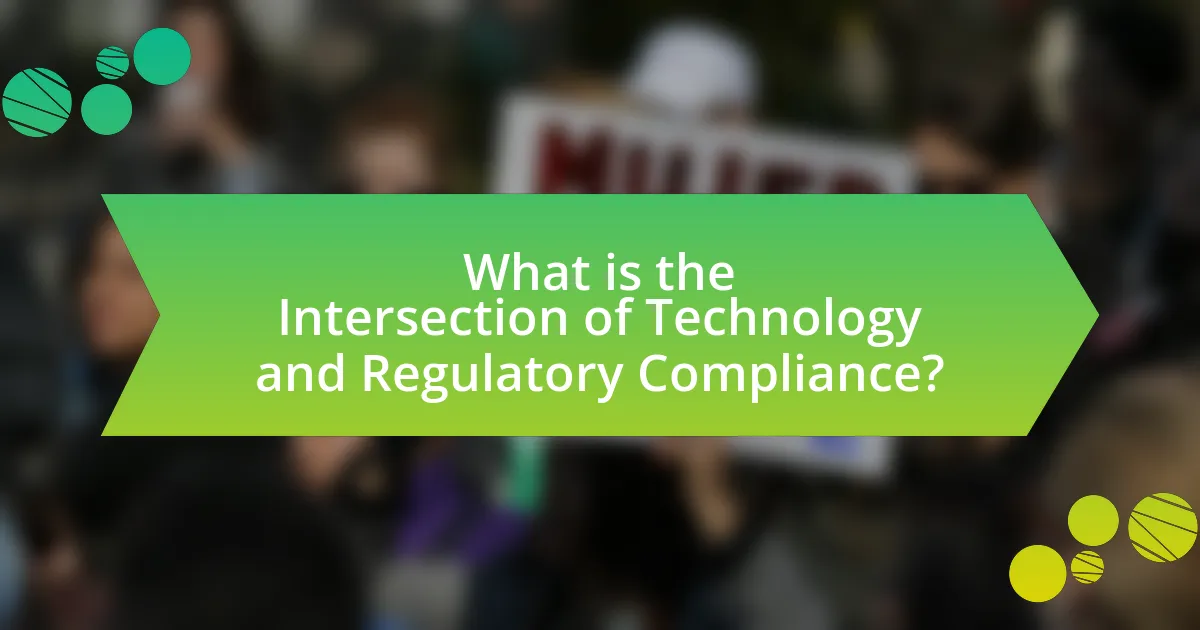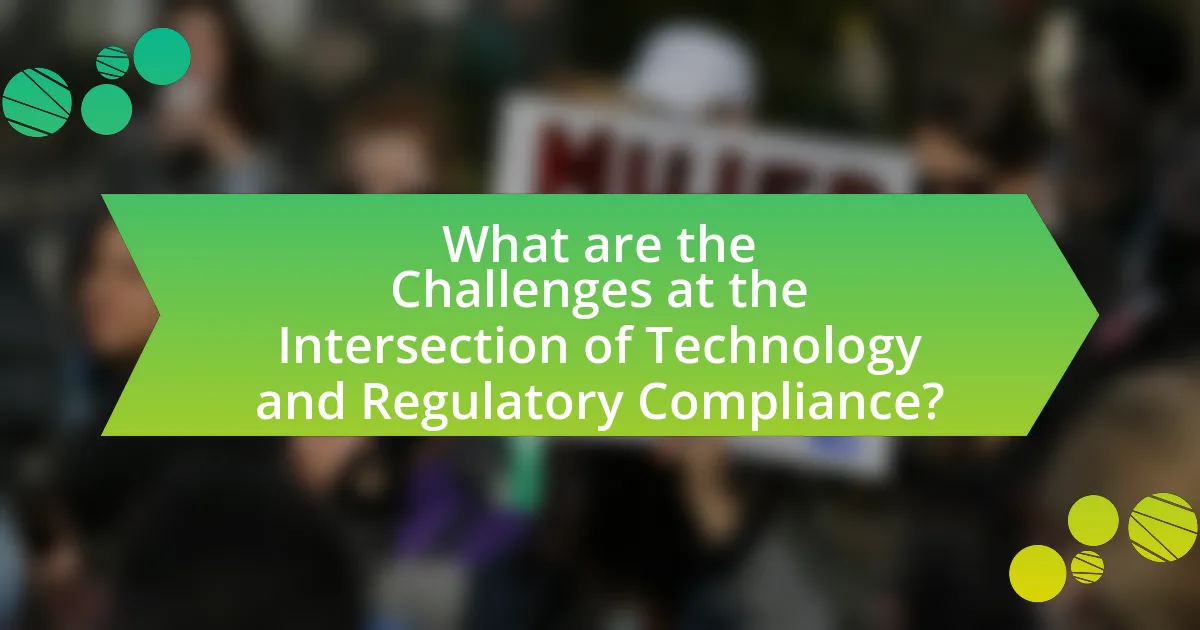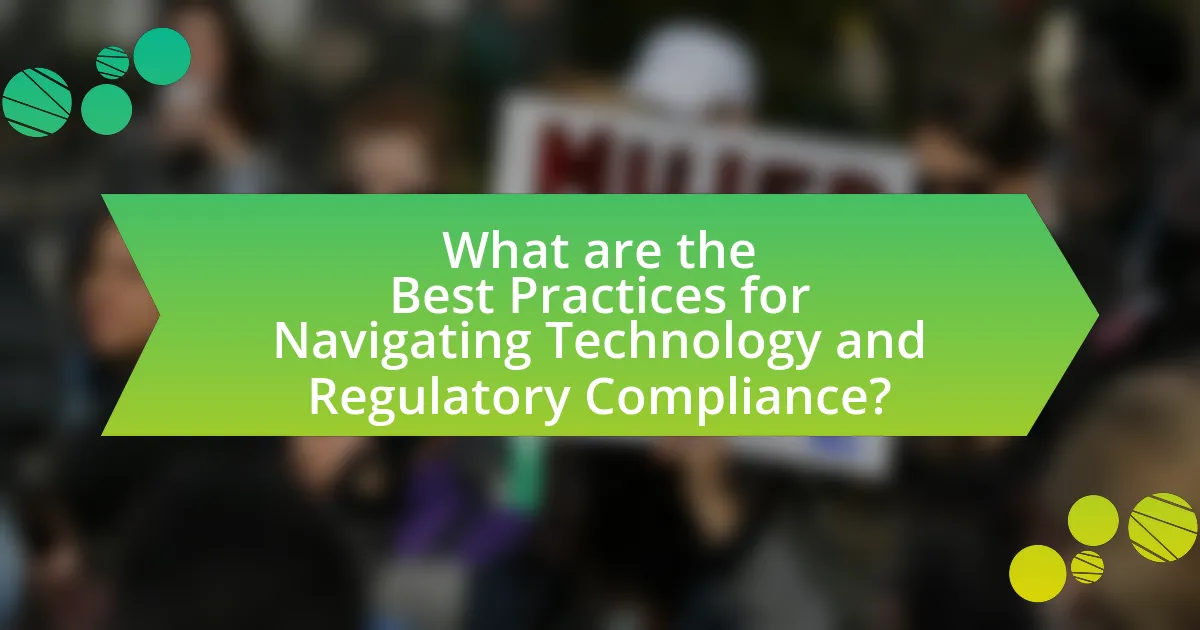The article explores the intersection of technology and regulatory compliance, highlighting how organizations integrate technological solutions to meet legal requirements such as GDPR and HIPAA. It discusses the interaction between technology and compliance, emphasizing the role of artificial intelligence, blockchain, and data analytics in automating compliance processes and enhancing accuracy. The article also addresses the challenges organizations face, including evolving regulations and data privacy concerns, while outlining best practices for effective compliance management. Additionally, it examines the implications of data privacy laws on technology use and the importance of training and ongoing education in maintaining compliance.

What is the Intersection of Technology and Regulatory Compliance?
The intersection of technology and regulatory compliance refers to the integration of technological solutions to meet legal and regulatory requirements. Organizations increasingly utilize software, data analytics, and automation to ensure adherence to laws such as GDPR, HIPAA, and others, which require stringent data protection and reporting standards. For instance, a 2021 report by Deloitte highlighted that 60% of companies leverage technology to enhance compliance processes, demonstrating the growing reliance on tech-driven solutions to navigate complex regulatory landscapes effectively.
How do technology and regulatory compliance interact?
Technology and regulatory compliance interact by enabling organizations to automate compliance processes and ensure adherence to legal standards. For instance, technologies such as artificial intelligence and machine learning can analyze vast amounts of data to identify compliance risks and streamline reporting, thereby reducing human error. According to a report by Deloitte, 60% of organizations that implemented compliance technology reported improved efficiency in their compliance operations. This demonstrates that the integration of technology not only enhances compliance accuracy but also supports organizations in meeting regulatory requirements more effectively.
What are the key technologies influencing regulatory compliance?
Key technologies influencing regulatory compliance include artificial intelligence, blockchain, and data analytics. Artificial intelligence automates compliance processes, enabling organizations to analyze vast amounts of data for regulatory adherence efficiently. Blockchain enhances transparency and traceability in transactions, which is crucial for meeting regulatory standards. Data analytics provides insights into compliance risks and trends, allowing organizations to proactively address potential issues. These technologies collectively streamline compliance efforts and reduce the likelihood of regulatory breaches, as evidenced by numerous case studies demonstrating improved compliance outcomes through their implementation.
How does regulatory compliance shape technology development?
Regulatory compliance significantly shapes technology development by establishing standards that guide innovation and implementation. Compliance requirements, such as data protection laws like GDPR, compel technology companies to design systems that prioritize user privacy and security. For instance, the introduction of GDPR in 2018 led to a surge in the development of privacy-focused technologies, including enhanced encryption methods and user consent management tools. This regulatory framework not only influences the features of new technologies but also drives companies to invest in compliance-related innovations, ensuring that products meet legal standards while fostering consumer trust.
Why is understanding this intersection important?
Understanding the intersection of technology and regulatory compliance is crucial because it enables organizations to navigate complex legal frameworks while leveraging technological advancements. This understanding helps businesses mitigate risks associated with non-compliance, which can lead to significant financial penalties and reputational damage. For instance, a study by the Ponemon Institute found that the average cost of non-compliance for organizations can exceed $14 million annually. Additionally, integrating technology into compliance processes can enhance efficiency and accuracy, allowing for real-time monitoring and reporting, which is essential in today’s fast-paced regulatory environment.
What risks arise from neglecting technology in compliance?
Neglecting technology in compliance poses significant risks, including increased vulnerability to regulatory violations and operational inefficiencies. Organizations that fail to adopt technological solutions may struggle to keep up with evolving regulations, leading to potential fines and legal repercussions. For instance, a study by the Ponemon Institute found that companies using manual compliance processes face a 30% higher risk of non-compliance compared to those leveraging automated systems. Additionally, without technology, organizations may experience slower response times to compliance issues, resulting in missed deadlines and increased costs associated with remediation efforts.
How can effective compliance enhance technological innovation?
Effective compliance enhances technological innovation by creating a structured environment that fosters creativity while minimizing risks. When organizations adhere to regulatory standards, they establish clear guidelines that can streamline processes, allowing teams to focus on innovative solutions rather than navigating legal uncertainties. For instance, companies that comply with data protection regulations, such as GDPR, are often more trusted by consumers, leading to increased adoption of new technologies. This trust can drive innovation as businesses feel secure in developing and deploying new products and services. Additionally, compliance frameworks can encourage investment in research and development, as they provide a roadmap for aligning innovative efforts with legal requirements, ultimately leading to sustainable technological advancements.

What are the Challenges at the Intersection of Technology and Regulatory Compliance?
The challenges at the intersection of technology and regulatory compliance include rapidly evolving technology outpacing existing regulations, data privacy concerns, and the complexity of compliance frameworks. As technology advances, regulations often lag behind, creating gaps that can lead to non-compliance risks for organizations. For instance, the introduction of artificial intelligence and machine learning raises questions about accountability and transparency, which current regulations may not adequately address. Additionally, data privacy laws like the General Data Protection Regulation (GDPR) impose strict requirements on data handling, complicating compliance for tech companies that rely on large datasets. The intricate nature of compliance frameworks, which can vary significantly across jurisdictions, further complicates adherence, as organizations must navigate a patchwork of regulations while implementing technological solutions.
What common obstacles do organizations face?
Organizations commonly face obstacles such as regulatory compliance challenges, technological integration issues, and resistance to change. Regulatory compliance challenges arise from the complexity of laws and regulations that vary by industry and region, making it difficult for organizations to ensure adherence. For instance, a survey by Deloitte found that 60% of organizations struggle to keep up with changing regulations, which can lead to costly penalties and reputational damage. Technological integration issues occur when organizations attempt to implement new technologies that do not align with existing systems, resulting in inefficiencies and increased operational costs. Additionally, resistance to change is prevalent, as employees may be hesitant to adopt new processes or technologies, hindering organizational progress. According to McKinsey, 70% of change initiatives fail due to employee resistance, underscoring the importance of effective change management strategies.
How do evolving regulations impact technology adoption?
Evolving regulations significantly impact technology adoption by creating both barriers and incentives for organizations. As regulations change, companies must adapt their technologies to ensure compliance, which can lead to increased costs and delays in implementation. For instance, the General Data Protection Regulation (GDPR) in Europe has prompted businesses to adopt advanced data protection technologies to meet stringent privacy requirements. This regulatory framework has accelerated the development and integration of technologies such as encryption and data anonymization. Additionally, evolving regulations can drive innovation by encouraging the development of new solutions that comply with emerging standards, as seen in the rise of fintech solutions that adhere to financial regulations. Thus, the relationship between evolving regulations and technology adoption is dynamic, influencing both the pace and direction of technological advancements.
What are the implications of data privacy laws on technology use?
Data privacy laws significantly impact technology use by imposing strict regulations on data collection, storage, and processing. These laws, such as the General Data Protection Regulation (GDPR) in Europe, require organizations to obtain explicit consent from users before collecting personal data, thereby influencing how technology companies design their services and applications. Compliance with these regulations often necessitates the implementation of advanced security measures, data anonymization techniques, and transparent data handling practices, which can increase operational costs and complexity for businesses. Furthermore, non-compliance can lead to substantial fines; for instance, GDPR violations can result in penalties of up to 4% of a company’s global revenue. Thus, data privacy laws shape the technological landscape by driving innovation in privacy-preserving technologies while also creating challenges for businesses in maintaining compliance.
How can organizations overcome these challenges?
Organizations can overcome challenges related to technology and regulatory compliance by implementing robust compliance management systems. These systems facilitate the tracking of regulatory changes, ensuring that organizations remain up-to-date with evolving laws and standards. For instance, a study by the International Compliance Association found that organizations with dedicated compliance technology reported a 30% reduction in compliance-related incidents. Additionally, regular training programs for employees on compliance requirements can enhance awareness and adherence, further mitigating risks associated with non-compliance.
What strategies can be implemented for effective compliance?
Effective compliance can be achieved through the implementation of robust training programs, regular audits, and the integration of technology solutions. Training programs ensure that employees understand regulatory requirements and organizational policies, which is essential for fostering a culture of compliance. Regular audits help identify gaps in compliance and provide opportunities for corrective actions, thereby minimizing risks. Additionally, technology solutions such as compliance management software streamline processes, enhance monitoring capabilities, and facilitate real-time reporting, which collectively improve adherence to regulations. According to a study by the Association of Certified Fraud Examiners, organizations with comprehensive compliance training programs experience 50% fewer compliance violations, underscoring the importance of these strategies.
How can technology solutions streamline compliance processes?
Technology solutions can streamline compliance processes by automating data collection, monitoring, and reporting tasks. Automation reduces manual errors and accelerates the compliance workflow, allowing organizations to respond quickly to regulatory changes. For instance, compliance management software can track regulatory updates in real-time, ensuring that businesses remain informed and compliant without extensive manual oversight. According to a report by Deloitte, organizations that implement technology solutions for compliance can reduce compliance costs by up to 30% while improving accuracy and efficiency.

What are the Best Practices for Navigating Technology and Regulatory Compliance?
The best practices for navigating technology and regulatory compliance include implementing a robust compliance management system, conducting regular audits, and ensuring continuous employee training. A compliance management system helps organizations systematically manage compliance obligations, while regular audits identify gaps and areas for improvement. Continuous training ensures that employees are aware of regulatory requirements and technological changes. According to a 2021 report by Deloitte, organizations that prioritize compliance management and training reduce the risk of regulatory breaches by up to 30%.
What role does training play in compliance with technology?
Training is essential for ensuring compliance with technology by equipping employees with the necessary knowledge and skills to adhere to regulatory standards. Effective training programs help organizations understand legal requirements, mitigate risks associated with technology use, and foster a culture of compliance. For instance, a study by the Ponemon Institute found that organizations with comprehensive training programs experienced 50% fewer data breaches compared to those without such initiatives. This demonstrates that targeted training not only enhances awareness but also significantly reduces compliance-related incidents.
How can organizations ensure their staff is well-informed?
Organizations can ensure their staff is well-informed by implementing regular training programs and utilizing effective communication channels. Regular training sessions, such as workshops and e-learning modules, keep employees updated on industry regulations and compliance requirements, which is crucial in a rapidly changing regulatory landscape. For instance, a study by the Society for Human Resource Management found that organizations with structured training programs experience a 30% increase in employee knowledge retention. Additionally, leveraging technology such as intranet platforms and collaboration tools facilitates real-time information sharing, ensuring that staff have access to the latest updates and resources. This combination of training and technology creates a well-informed workforce capable of navigating compliance challenges effectively.
What resources are available for ongoing education in compliance?
Ongoing education in compliance is supported by various resources, including online courses, professional certifications, webinars, and industry conferences. Online platforms such as Coursera and edX offer courses on compliance topics, while organizations like the Compliance Certification Board provide certifications that enhance professional credentials. Additionally, webinars hosted by compliance associations, such as the Society of Corporate Compliance and Ethics, offer insights into current regulatory changes. Industry conferences, like the Compliance Week Annual Conference, facilitate networking and knowledge sharing among compliance professionals. These resources ensure that individuals stay informed about evolving compliance standards and practices.
What tools and technologies can assist in compliance efforts?
Compliance efforts can be significantly enhanced by utilizing tools and technologies such as compliance management software, data analytics platforms, and automated reporting systems. Compliance management software, like LogicManager and ComplyAdvantage, provides organizations with frameworks to manage regulatory requirements efficiently. Data analytics platforms, such as Tableau and Power BI, enable organizations to analyze compliance data for trends and anomalies, ensuring proactive risk management. Automated reporting systems streamline the process of generating compliance reports, reducing human error and saving time. These technologies collectively improve accuracy, efficiency, and accountability in compliance efforts, as evidenced by a 2021 survey by Deloitte, which found that 78% of organizations using compliance technology reported improved compliance outcomes.
Which software solutions are most effective for compliance management?
The most effective software solutions for compliance management include LogicGate, ComplyAdvantage, and MetricStream. LogicGate offers a flexible platform that allows organizations to customize compliance workflows, ensuring adherence to regulations like GDPR and HIPAA. ComplyAdvantage utilizes advanced machine learning to provide real-time risk assessments and monitor compliance with anti-money laundering regulations. MetricStream is known for its comprehensive governance, risk, and compliance (GRC) capabilities, enabling organizations to manage compliance across multiple frameworks efficiently. These solutions are validated by their widespread adoption in various industries, demonstrating their effectiveness in maintaining regulatory compliance.
How can automation improve compliance accuracy and efficiency?
Automation can significantly improve compliance accuracy and efficiency by minimizing human error and streamlining processes. Automated systems can consistently apply regulatory requirements across all operations, ensuring that compliance checks are performed uniformly and without oversight. For instance, a study by the International Journal of Information Management found that organizations implementing automation in compliance processes reduced errors by up to 50% and increased processing speed by 30%. This demonstrates that automation not only enhances accuracy but also accelerates compliance workflows, leading to more effective regulatory adherence.
What are the key takeaways for organizations?
Organizations must prioritize the integration of technology with regulatory compliance to enhance operational efficiency and mitigate risks. Embracing advanced technologies such as artificial intelligence and data analytics enables organizations to automate compliance processes, ensuring accuracy and timeliness in reporting. For instance, a study by Deloitte found that companies leveraging technology for compliance can reduce costs by up to 30% while improving compliance accuracy. Additionally, organizations should foster a culture of continuous learning and adaptation to stay ahead of evolving regulations, as regulatory landscapes are increasingly dynamic. This proactive approach not only safeguards against potential penalties but also builds trust with stakeholders.
How can organizations create a culture of compliance and innovation?
Organizations can create a culture of compliance and innovation by integrating compliance into their core values and encouraging innovative thinking within regulatory frameworks. This approach involves establishing clear compliance guidelines that align with the organization’s mission while fostering an environment where employees feel empowered to propose new ideas and solutions. For instance, companies like Google have successfully implemented this by allowing employees to dedicate a portion of their time to innovative projects, which has led to the development of new products while maintaining adherence to regulatory standards. Additionally, regular training and open communication about compliance requirements can enhance understanding and promote a proactive attitude towards both compliance and innovation.
What steps should be taken to stay ahead of regulatory changes?
To stay ahead of regulatory changes, organizations should implement a proactive compliance strategy that includes continuous monitoring of regulatory developments, engaging with industry associations, and leveraging technology for real-time updates. Continuous monitoring involves regularly reviewing government publications, regulatory agency announcements, and legal updates to identify potential changes. Engaging with industry associations provides insights and collective knowledge on upcoming regulations, while technology solutions, such as compliance management software, can automate tracking and alert organizations to relevant changes. According to a 2021 Deloitte survey, 78% of organizations that adopted technology for compliance reported improved efficiency in managing regulatory changes.






